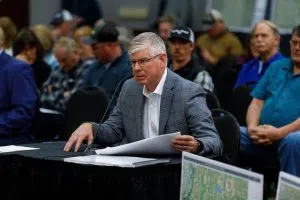 (Joshua Haiar – South Dakota Searchlight) – An Iowa company proposing a carbon dioxide pipeline said it resubmitted its permit application to South Dakota regulators Tuesday with what the company described as “major reroutes.”
(Joshua Haiar – South Dakota Searchlight) – An Iowa company proposing a carbon dioxide pipeline said it resubmitted its permit application to South Dakota regulators Tuesday with what the company described as “major reroutes.”
A new route map was not immediately available from the company or state officials.
The move comes more than a year after the South Dakota Public Utilities Commission rejected Summit Carbon Solution’s initial application. At that time, the commission cited the route’s non-compliance with county laws mandating minimum distances between pipelines and existing features.
Summit’s latest South Dakota route includes 700 miles with connections to 14 ethanol plants in the eastern part of the state, including a proposed sustainable aviation fuel plant, the company said. Overall, the $9 billion pipeline would span 2,500 miles with connections to 57 ethanol plants in five states.
Summit already has permits in Iowa and North Dakota. A decision is pending in Minnesota, and Nebraska has no state permitting processing for carbon pipelines.
Project details
Summit plans to capture some of the carbon dioxide produced during ethanol production, liquefy it, and transport it via pipeline to North Dakota for injection underground in a process known as “sequestration.” That could qualify the company for billions of dollars in federal tax credits that are intended to incentivize the removal of heat-trapping carbon dioxide from the atmosphere.
A Tuesday news release from Summit said the pipeline could also make carbon available for uses including green methanol, water treatment, food processing and dry ice production.
The sequestration area is near the oilfields of western North Dakota, and project critics have long alleged that some of the carbon dioxide in the pipeline could be used for enhanced oil recovery. In that process, liquid CO2 is injected into aging oil wells to extract additional crude oil.
Summit’s website says the pipeline “will not be used for enhanced oil recovery.” Yet during a 2023 permit hearing in Iowa, Summit Chief Operations Officer Jimmy Powell said it’s “a possibility” that Summit could transport CO2 for “another carrier” that might use it for enhanced oil recovery.
The project has faced staunch opposition in South Dakota from landowners who don’t want the pipeline crossing their land, and from landowners and others concerned about potential leaks of toxic carbon dioxide plumes.
A Tuesday press release from Summit mentioned reroutes in Spink, Brown, McPherson and Lincoln counties — areas where local siting laws played a role in state regulators’ denial of Summit’s first permit application.
Ed Fischbach, a pipeline opponent and Aberdeen-area farmer, said the company previously claimed it could not abide by those local laws.
“That’s what they were saying under oath,” Fischbach said. “It is just more evidence that this company has not been telling the truth. They said, ‘There’s no way we can make these work, and they’re too restrictive.’”
The company said Tuesday it incorporated input from landowners and local officials during a yearlong series of negotiations.
“This project represents a once-in-a-generation opportunity to strengthen South Dakota’s agricultural future while advancing energy innovation,” said Lee Blank, Summit’s CEO, in a statement. He emphasized the company’s commitment to “working hand in hand with landowners and communities” to achieve a balanced solution.
Lawsuits pending, legislation possible
But the proposal is politically fraught in South Dakota. Fourteen incumbent state legislators lost to challengers in the June primary election, and the incumbents’ support of a controversial pipeline law was a factor in many races.
Legislators and Gov. Kristi Noem approved the law last winter, describing it as balanced approach to implement new protections for landowners and county governments while leaving open a regulatory door for the pipeline’s potential approval.
Opponents attacked a portion of the law they said would require counties to prove their siting laws are reasonable, rather than requiring Summit prove them unreasonable. Opponents also gathered petition signatures and forced the law onto the November ballot, where 59% of voters rejected it.
One of the many organizations that joined in the fight against the law was Dakota Rural Action. Chase Jensen, an organizer with the group, said voters sent a message with their rejection of Referred Law 21.
“It shows that South Dakota trusts local governments to regulate these projects,” Jensen said. “Summit’s new route will be telling whether they heard the message or not.”
Summit aims to begin construction in 2026 and start operations in 2027. State regulators will review Summit’s new application in the coming months, which could overlap with legislative action on the proposal. Many of the new South Dakota legislators who will take office in January are opponents of the project’s potential use of eminent domain, a legal process for obtaining access to land from unwilling landowners in exchange for just compensation.
A further complication for the company is a set of lawsuits in South Dakota challenging Summit’s right to use eminent domain.
In August, the South Dakota Supreme Court ruled that Summit had not yet proven its status as a “common carrier,” a designation necessary to the eminent domain process. The court sent the lawsuits back to lower courts, where Summit said it would try to prove its case.









